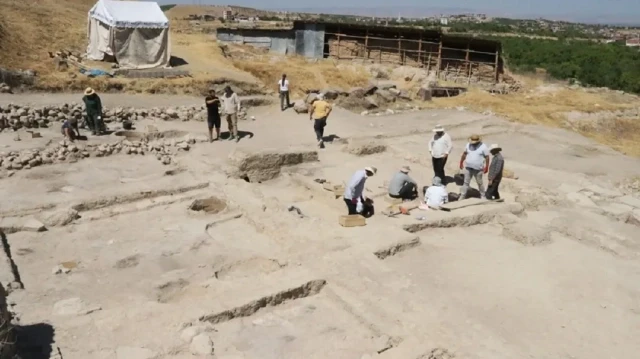
Excavation, restoration efforts uncover insights into Late Hittite capital’s architecture and defenses
Restoration efforts continue on Late Hittite-era walls at Arslantepe Mound, a 7,000-year-old UNESCO World Heritage site in eastern Türkiye's Malatya province, which were damaged during Türkiye’s devastating earthquakes in 2023.
Following the devastating earthquakes in 2023, walls were damaged, Francesca Balossi Restelli, head of the excavation team, told Anadolu, adding: “We had no choice but to carry out restoration work.”
She said they laid stone foundations last year and that this year, sections of the wall are being restored with new mudbricks, using traditional techniques that match the original construction.
Restelli also explained the excavation work at the site, saying it began about three weeks ago and is still ongoing in the mound's northern, western, and southern sections.
She noted that the team is currently working in the layers dating back to the Late Hittite period in the northern section, adding: "We are excavating a large public building dated to around 1000 B.C." The structure has thick mudbrick walls covered in white plaster and is remarkably well preserved, she said.
She said excavations have reached over a meter deep inside a well-preserved Late Hittite building but have yet to reach the floor, with clean soil and few pottery finds indicating the structure was deliberately filled in during that period, a significant but not yet fully understood discovery.
In the western area, she said, excavations are focusing on layers from the Late Chalcolithic 2 period. “We are reaching some of the earliest layers of Arslantepe here. We are currently uncovering small mudbrick houses with courtyards, typically two-roomed structures. There is a large amount of pottery in this area.”
Restelli also noted that excavations in the southern part of the mound are targeting layers from the Early Bronze Age.
She said that they have uncovered houses and various artifacts, including a hearth, and that, despite some damage caused by the layers being close to the surface, ceramics and other materials help date the findings to around 1800 B.C.
- ‘Capital in the Late Hittite period’
Emphasizing the historical significance of Arslantepe, Restelli said that in the Late Hittite period, the site served as a capital.
“The king of Melid resided here, and as in other Hittite cities, they built a city wall around the area housing the king and administrators. The gate of this wall faced directly north, toward the Euphrates River, as the kingdom’s border lay in that direction,” she said.
She added that the red mudbrick fortification walls, discovered in previous excavation seasons, also date back to the Late Hittite period and formed part of the city’s outer defenses.







